|
||||||
|
CASTANEA. Chestnuts. [Fagaceae] |
|
|
Only one species of Castanea is recorded in Britain - Sweet chestnut (C. sativa). Nine, possibly 10, species of moth are recorded mining Castanea. A key to the European miners recorded on Castanea is provided in Bladmineerders van Europa. |
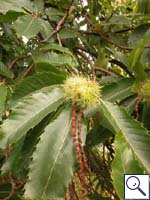 Sweet Chestnut - Castanea sativa |
|
Key for the identification of the known mines of British |
1a > Leaf-miner and case-bearer: The larva lives outside the mine, protected by a case, and feeds on the underlying plant tissues via a hole cut in the epidermis. From that point it eats away as much leaf tissue as it can reach without fully entering the mine. Mine does not contain frass (Coleophora species) |
1b > Leaf-miner, but not a case-bearer: The larva lives mainly inside the mine. Mine usually contains frass. In later instars the larva may live sandwiched between two more or less circular sections cut from the leaf. |
2a > Leaf-miner and case-bearer: The early case is tiny and the larva makes a series of tiny holes on the leaf. After overwintering it makes a shiny pistol shaped case in spring and window feeds. The young larva, before hibernation, makes tiny mines, sometimes tens in one leaf. After hibernation window feeding is done. In this latter stage the larva lives in a shining black pistol case of about 7 mm, that, with a mouth angle of 70°-80°, stands almost perpendicular on the leaf. |
|
Coleophora anatipenella (Hübner, 1796) [Lepidoptera: Coleophoridae]. |
2b > Leaf-miner and case-bearer: Larva mines leaves. The case is enlarged several times by mining a leaf-edge and inserting the existing case into the mine which is joined with silk. The final case is 7-8 mm long. Larva in a composite leaf case, composed of large leaf fragments. Characteristically, the leaf fragments are attached in a failry untidy way. In spring the case has two colours, because the old material (dull yellowish, grey or pink) dates from before the hibernation, while new, reddish brown material dates from after the winter. The case finally is about 7-8 mm long; the mouth angle is 40-45°.. |
|
Coleophora binderella Staudinger, 1859 [Lepidoptera: Coleophoridae]. |
2c > Leaf-miner and case-bearer: First case formed of silk, including a small leaf fragment, larva mining leaves. Feeding in spring in a new case on catkins and also mining leaves. Very similar to case of C. lutipennella. Light brown, trivalved, tubular silken case of c. 7 mm with a mouth angle of c. 45°. Immediately after eclosion the larva makes a tiny blotch mine of about 1.7 x 0.7 mm, then excises a leaf case from it. Later this first case is enlarged with silk. No other miner on Oak makes a similar mine, and its presence, in autumn and in combination with full depth mines, is a good indication for flavipennella. The small leaf fragment remains part of the case. In the fully developed case its is to be found mid-dorsally, near the anal end. It is not at all easy to find, as it is withered and discoloured, and may be covered by detritus and newer silk. But if it is seen, it forms the single reliable character to distinguish the case from that of C. lutipennella, living on the same hostplants. |
 Coleophora flavipennella larva, dorsal Image: © Willem Ellis (Bladmineerders van Europa) |
|
Coleophora flavipennella (Duponchel, 1843) [Lepidoptera: Coleophoridae]. |
2c > Leaf-miner and case-bearer: The larvae of this species feed on oak, forming a pear-shaped silken case, initially on the underside of a leaf, moving its case to an angle of twigs to over-winter. First case formed of silk, larva mining leaves. Feeding in spring in a new case on catkins and also mining leaves. Very similar to case of C. flavipennella. Light brown, trivalved, tubular silken case of c. 7 mm; mouth angle c. 45°. Immediately after eclosion the larva begins the construction of its case, that entirely consists of silk. |
|
Coleophora lutipennella (Zeller, 1838) [Lepidoptera: Coleophoridae]. |
2d > Leaf-miner and case-bearer: The larva feeds on a wide range of trees, shrubs and herbs, favouring Rosaceae, but not exclusively. The fully developed cased larva may be found active in October and again, after winter diapause, in April. Cases, about 6 mm, of diapausing larvae may be found through winter, fixed to a tree or fence post. The dorsal surface of the case is usually covered in leaf fragments, but they can sometimes be worn off almost smooth. The ventral surface is swollen at the middle and has a keel, which usually bends upwards at the posterior. The cases of C. ahenella (on Rhamnus, Frangula, Viburnum and Cornus) and C. potentillae (case less swollen, keel not bent up, resting position less prone) are very similar. Brownish lobe case that lies almost flat on the leaf, either on the upper or on the lower side. Case widest about the middle. Ventrally there is a distinct keel. Mouth angle 0°. Full depth mines rather large. The flaps of cuticular tissue that serve to enlarge the case are cut out of the upper epidermis. (contrary to C. ahenella and C. potentillae, that use tissue from the lower epidermis). The removal of these tissue flaps creates holes that are much larger than those that serve as the entrance to the mine. |
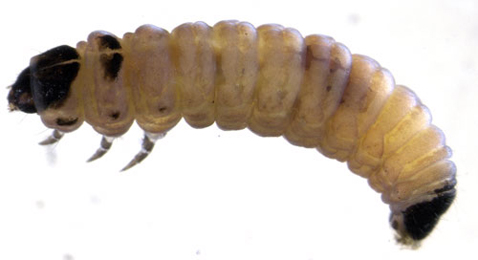 Coleophora violacea larva, lateral Image: © Willem Ellis (Bladmineerders van Europa) |
|
Coleophora violacea (Ström, 1783) [Lepidoptera: Coleophoridae]. |
3a > Leaf-miner: The larva begins with a short, full depth corridor, often along the midrib or a thick vein. Most of the mine with a thick frass line. The larva soon leaves the mine, and starts causing window-feeding, later eating holes in the leaf. The larval chamber (the space occuped by the larva, while in the mine, obviously free of frass) is more than three times as long as wide. |
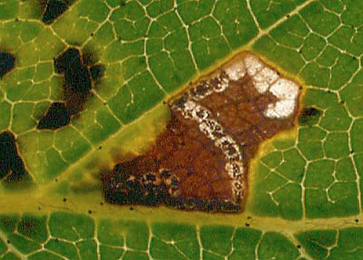 Mine of Bucculatrix demaryella on Betula pubscens Image: © Willem Ellis (Bladmineerders van Europa) |
|
Bucculatrix demaryella (Duponchel, 1840) [Lepidoptera: Bucculatricidae]. |
3b > Leaf-miner: The mine is a short contorted gallery close to the midrib of a leaf, containing broken black frass. Egg at the upperside of the leaf, generally adjacent to the midrib. The mine is a short, angular corridor with much black frass and a relatively large larval chamber. The larvae soon leave their mines and start causing lower-surface window feeding. |
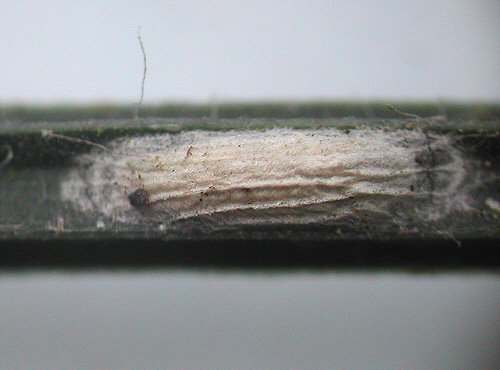 Bucculatrix ulmella cocoon Image: Rob Edmunds (British leafminers) |
|
Bucculatrix ulmella Zeller, 1848 [Lepidoptera: Bucculatricidae]. |
3c > Leaf-miner: The larva at first mines the leaves in a gallery leading to a blotch. Subsequently the larva forms a succession of cones (usually three) by folding the tips of the leaves, and feeding withinthem. At first a narrow lower-surface epidermal gallery, regularly intersecting itself. In the next stage the mine becomes full depth. It remains a small mine, either rectangular, or, more frequently, a triangle in a vein axil, with frass along the sides. After a while the mine is vacated and the larva continues in a leaf roll. No differences, either the mine or in larva, are known from C. robustella. Moreover a temporal overlap exists between the single larval generation of C. alchmiella, and the second larval generation of robustella. Pupation in a white cocoon. Only the pupae and adults enable a reliable identification. |
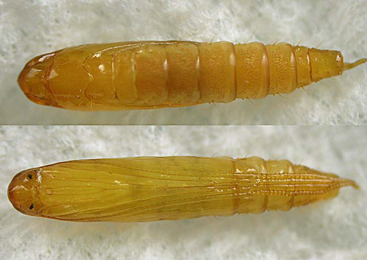 Pupae of Caloptilia alchimiella Image: © Charlie Streets (British leafminers) |
|
Caloptilia alchimiella (Scopoli, 1763) [Lepidoptera: Gracillariidae]. |
3d > Leaf-miner: Initially in short gallery becoming a blotch in the leaf. Later in up to three cones at the edge of the leaf. The mines and cones are the same as for Caloptilia alchimiella and the moth needs to be bred out to confirm identity. Mine indistinguishable from that of Caloptilia alchimiella.The pupa forms in a cocoon under a turned over leaf edge. |
|
Caloptilia robustella Jäckh, 1972 [Lepidoptera: Gracillariidae]. |
3e > Leaf-miner: Blotch mine, frass in long threads. The mine can be confused with that of the beetle Orchestes pilosus, but the mine of O. pilosus is darker and smaller when mature. The frass of E.subpurella is also typically 'spaghetti' like in appearance (British leafminers, as Eriocrania). Oviposition within the leaf tissue, some 2 mm away from the leaf margin. The mine begins as a narrow corridor of c. 5 mm, largely filled with granular frass. This corridor abruptly widens into a large, dirty-whitish, full depth blotch that lies against the leaf margin and usually runs over the previous corridor. Frass here in long threads. Often several larvae in a mine after fusion of the original solitary mines. When the mines are made the foliage still is very tender, and the mines quickly wither away; they cannot be found later in summer. Probably for he same reason the oviposition site almost always is a small hole. Pupation in the ground. |
|
Dyseriocrania subpurpurella (Haworth, 1828) [Lepidoptera: Eriocraniidae]. |
3f > Leaf-miner: A gallery which leads to blotch (no slit in lower epidermis so the frass accumulates in the blotch). Oviposition on the upperside of the leaf, next to a vein. The mine begins as a narrow corridor with a broad frass line, running along a vein. Generally the corridor runs along the midrib, or along a lateral vein. In the latter case the direction usually is towards the midrib. The corridor abruptly widens into a blotch, containing much frass, laying against the midrib. Pupation external. |
|
Ectoedemia heringi (Toll, 1934) [Lepidoptera: Nepticulidae]. |
3g > Leaf-miner: The larvae mine oak leaves, initially in a gallery following a vein, then creating a triangular blotch between vein and midrib. It can be distinguished from the similar mines of E. heringi by the presence of a slit in the lower epidermis which allows frass and water to pass. Oviposition on the upperside of the leaf, next to a vein. The mine begins as a narrow corridor, filled with frass, running along a vein: usually the midrib, or along a lateral vein and then running in the direction of the midrib. The corridor abruptly widens into a blotch, usually in the axil of the midrib and a side vein. The larva makes a slit in the lower epidermis of the blotch, by which part of the frass is ejected. Pupation external. |
|
Ectoedemia subbimaculella (Haworth, 1828) [Lepidoptera: Nepticulidae]. |
3h > Leaf-miner: The larvae mine leaves at first, forming a blotch mine, later descending to the ground in a portable case and feeding on dead leaves. Oviposition is by way of an ovipositor, therefore no egg shell visible. The larva makes a small, roundish, blotch; often several in a leaf. Already after its first moult it makes an excision out of the mine, in size almost equal to the blotch (3-4 mm). Thus sandwiched it drops to the ground and continues feeding on dead leaf material. |
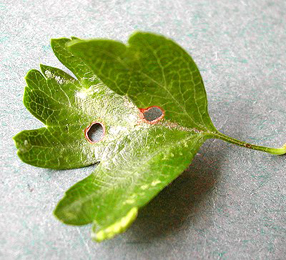 Mines of Incurvaria masculella Image: © Rob Edmunds (British leafminers) |
|
Incurvaria masculella (Denis & Schiffermüller, 1775) [Lepidoptera: Incurvariidae]. |
3i > Leaf-miner: A long, whitish smoothly-curved upper-surface mine with broken black frass. Oviposition is by means of an ovipositor; what remains is a small scar: no egg shell is visible at the start of the mine. From here a long, sometimes very long, slender, full depth corridor winds throught the leaf, not steered by leaf margin or the leaf venation. The midrib is crossed effortless; the corridor frequently also crosses itself; the section of the leaf cut off then usally turns brown and dies off. Frass in a narrow central line. The larva vacates the mine prior to pupation through an exit in the upper epidermis. The vacated larval chamber is proportionally much longer than in the case of Stigmella mines ( > 3 x longer than broad). Pupation in a silken cocoon suspended from threads attached to food plant or other vegetation. |
|
Lyonetia clerkella (Linnaeus, 1758) [Lepidoptera: Lyonetiidae]. |
3j > Leaf-miner: The mine is oval on Q. ilex (note - there may be several mines in the leaf), and similar to P. quercifoliella on deciduous oaks. It is between adjacent veins on beech and hornbeam. Small, oval, lower-surface tentiform mine, 9-14 mm long, mostly between two lateral veins. The lower epidermis with a single sharp fold (sometimes forked near its end). Pupa in very flimsy cocoon, that contains a bit of frass laterally and at the rear end. |
|
Phyllonorycter messaniella (Zeller, 1846) [Lepidoptera: Gracillariidae]. |
3k > Leaf-miner: Upper surface blotch, often rather narrow where it begins, but without a real initial corridor. Frass in gradually larger grains scattered in the mine. Never more than one larva in a mine. Pupation outside the mine. The larvae of sawflies have at least six thoracic legs (although they may be reduced or absent), a head capsule and chewing mouthparts with opposable mandibles but no abdominal legs. |
|
Profenusa pygmaea (Klug, 1816) [Hymenoptera: Tenthredinidae]. |
3l > Leaf-miner: The gallery is long and sinuous, filled with greenish frass. The initial mine is greenish/brown and becomes more visible as it ages and goes browner. Ovipostion close to a thick vein, mostly at the upper side. The mine is a long, slowly widening, slender corridor, with a characteristic sinuous course. Frass completely filling the corridor, in clear arcs, green when fresh, brown later. Fresh mines are almost concolorous with the leaf, and not very apparent. |
|
Stigmella basiguttella (Heinemann, 1862) [Lepidoptera: Nepticulidae]. |
3m > Leaf-miner: The gallery is long and broad, frass dispersed in later part of mine. Oviposition on the leaf underside, almost always close to a thick vein. Mine a fairly long, rather slender corridor. Frass in a broad, often interrupted central band; locally it may be in coiled. |
|
Stigmella samiatella (Zeller, 1839) [Lepidoptera: Nepticulidae]. |
3n > Leaf-miner: A chestnut brown blotch on upper side of leaf, frass in concentric arcs. Brick red, upper-surface blotch, not preceded by a corridor. Almost all frass is ejected through a slit in the upper epidermis, at the margin of the mine. Characteristic is a pattern of fine concentric lines around the site of oviposition. Rather soon the larva begins to make a flat saucer-shaped cocoon. During feeding pauses it rests here in a horse-shoe position. |
|
Tischeria dodonaea Stainton, 1858 [Lepidoptera: Tischeriidae]. |
3o > Leaf-miner: A whitish blotch on upper side of leaf. As the mine ages it can become a very pale brown colour. Milky white upper-surface primary blotch, sometimes with an orange hue; no trace of a preceding corridor. The inside is lined with much silk, but the mine remains completely flat. The larva soon starts making of a discoid cocoon, about in the centre of the mine. When not feeding it rests in a horshoe-like posture in its cocoon. The mine contains practically no frass, which is removed through a cut in the upper epidermis near the margin of the mine. Pupation within the mine. |
|
Tischeria ekebladella (Bjerkander, 1795) [Lepidoptera: Tischeriidae]. |
| Last updated 01-Jul-2019 Brian Pitkin | ||
.
